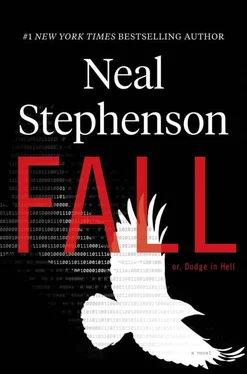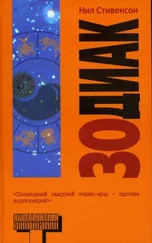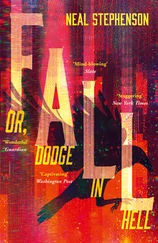Nowadays the building looked as it had in the very beginning, when the steelworkers and the concrete pumpers had roughed in the structure but the framers had not yet shown up with studs and drywall. The floor-to-ceiling windows still looked exactly like windows, but were now actually complicated robots in their own right, making all kinds of moment-to-moment decisions about which wavelengths, and how much of them, to let in or out of the building.
When she walked in, the place was crowded, more so than she’d seen it in years. The windows had figured out, or been told, that people wanted it pretty dark so that they could watch Bitworld. Of course, everyone had glasses that would show them whatever they felt like seeing. But at times like this there was a lot to be said for shared communal viewing, so they had fired up a larger and more powerful appliance, a stationary holographic projector that could pump out a lot of photons. So everyone was looking at its output with naked eyes, sharing the experience.
“You got here just in time!” someone exclaimed. It was Eva, a younger staff member whose mere presence and energy always made Zula feel very much like Uncle Claude. But she was a lovely person and Zula really didn’t mind.
“Just in time for what?” Zula asked. Her voice cracked and rasped; she didn’t use it much nowadays. She was maneuvering sideways trying to get a better angle; Fronk was respecting her overall dictates but doing so in a way that didn’t violate any safety heuristics. Zula, left to her own devices, would have used her little-old-lady prerogatives to elbow her way through the crowd. So progress was safe, polite, and slow.
She was piecing together glimpses. The display had been zoomed and panned to a part of the Landform that was not immediately familiar to her. She had a strong Uncle Claude feeling of not being able to make sense of what she was looking at. Then she spied a detail that helped her understand that this was the vicinity of the region once dubbed Escherville, exactly because it did not, in fact, make sense. It was a zone where notoriously the Landform Visualization Utility had never been able to pull together a coherent geometry. For decades, Ph.D. students and postdocs had tried to debug it. They had concluded that there was no bug; the LVU was working perfectly; the Landform hereabouts actually did not make any sense and so it just had to be shown in a suggestive and unstable way.
So Zula was looking at Escherville: the baroque castle-like structure that Dodge had built in the middle of it, the unsightly additions that El had made to it later. Not far away, the verdant zone where Verna tended to hang out with one of the new processes she had spawned—the one that looked female—inevitably, Eve. Probably, come to think of it, the namesake of the young woman at Zula’s elbow.
“What’s been going on?” Zula asked.
“Time Slip Ratio has been dropping—big processes using a lot of mana, loading the heck out of the systems,” said Eva. “It is actually approaching one now. That’s the lowest—”
“Lowest it has been in decades,” said Zula.
“But earlier today—in Meatspace time, that is—Sophia and the people she’s with teleported from the extreme southwest to an area north of here. Later they teleported a second time—not as far.”
Eva was so freaked out by that that Zula felt obliged to let her know, “Pluto used to teleport, way back when. We haven’t seen much of it since he moved to Landform Two.”
“Well anyway, they’ve been on the move southward ever since.”
“They?”
“Sophia and a group of other processes—including Corvallis and Maeve! And guess who has been hot on their trail?”
“I don’t need to guess,” said Zula. She had finally maneuvered to a position where she could clearly see El himself striding south across high territory toward Escherville. “All of this just happened in the last few hours?”
“Meatspace time? Yes.”
Zula glanced at a chronograph on Fronk’s arm. It was now eight o’clock in the evening. “How long is that in Bitworld?”
“Three days have passed there. But as you can see,” Eva went on, “it is slowing way down. And look! Now Verna is on the move!” Her attention had been drawn by exclamations from other viewers positioned farther to the east. Indeed it was possible to see a female form astride a horse, galloping as if to intercept El. The movement was too fast for the horse’s gait to look quite natural. But as Eva had pointed out, the Time Slip Ratio was dropping fast. So it got slower and more normal-looking as Verna drew closer.
“What is that woman carrying? It looks heavy!” Zula asked, pointing to a figure who seemed to be bent under a heavy load.
“We’ve been trying to categorize it. Grepping through ancient datasets. It seems to be the avatar of a cryptographic key. El made it a long time ago. Then he destroyed it. But not before Corvallis did something sneaky—used his privs to make a copy.”
“So, that’s the copy?”
“Apparently.”
One reason for the slowdown was obvious: the Landform was changing its shape. El was causing a bridge to grow across the gap separating him from Escherville, where Sophia and Maeve and several others were up to something at the approaches to the abandoned castle.
“I get it,” Zula said, in a bold assertion of non–Uncle Claude–ness. “He’s burning a lot of mana. Actually reshaping the Landform in real time. But just making a bridge isn’t expensive enough to slow things down that much.”
“True that,” said a young man nearby. Inevitably, Zula couldn’t remember his name, but she basically liked him, which was all that mattered. “Most of the slowdown is actually being caused by mana use from processes over in Landform Two. Old-school Pantheon gangstas. Including the notorious REAP.”
True That, as Zula had decided to call him, had been mostly hanging around in a corner of the big room with a smaller cluster of people who were looking at visualizations related to Landform 2: the separate chunk of Bitworld where the Pantheon seemed to hang out. Because it was all veiled in weird crypto over there, no one could really tell what it looked like, and so they were looking at abstractions: moving charts, fluctuating surfaces of data, rivers of text.
“And how do you know it is a Renascent Egdod-Associated Process?” Zula asked.
True That got an awkward look on his face. She could tell she’d committed a sort of faux pas. If she’d been a twenty-year-old intern he’d have confidently mansplained it to her. Because she was who she was, he couldn’t see a way forward.
She had to find it for him. “Never mind,” she said. “You can just tell. You have heuristics. REAPs just give off a certain holographic vibe. When one pops up, alarms go off.”
“Something like that, ma’am,” he answered with a nod so deep it almost became a bow. Behind him, she could see the thing they were looking at over there: one of those 3-D data visualizations you had to have a math degree to make sense of.
A notion occurred to her and she tossed it out, just to be mischievous: “Has anyone actually looked at it recently?”
“At what?”
“Landform Two. You know, my uncle’s neighborhood.”
“Well… you can’t see anything there, it’s… scrambled.”
She shrugged. “Just curious. You definitely can’t see if you don’t look.”
True That seemed to take her point. He raised a hand in a way indicative of working with some kind of interface. But Zula’s across-the-room conversation with him had become impossible as the larger group in the middle of the room had become very noisy. Not so much like professionals in a meeting. More in the manner of fans at a boxing match.
Читать дальше

![Нил Стивенсон - Криптономикон [litres]](/books/23868/nil-stivenson-kriptonomikon-litres-thumb.webp)






![Нил Стивенсон - Падение, или Додж в Аду. Книга первая [litres]](/books/392729/nil-stivenson-padenie-ili-dodzh-v-adu-kniga-perva-thumb.webp)
![Нил Стивенсон - Лавина [litres с оптимизированной обложкой]](/books/414066/nil-stivenson-lavina-litres-s-optimizirovannoj-ob-thumb.webp)

